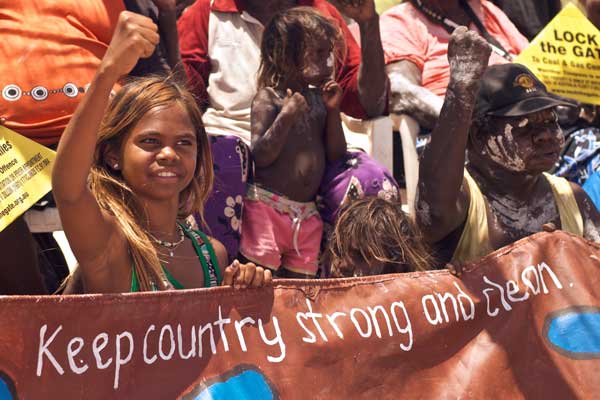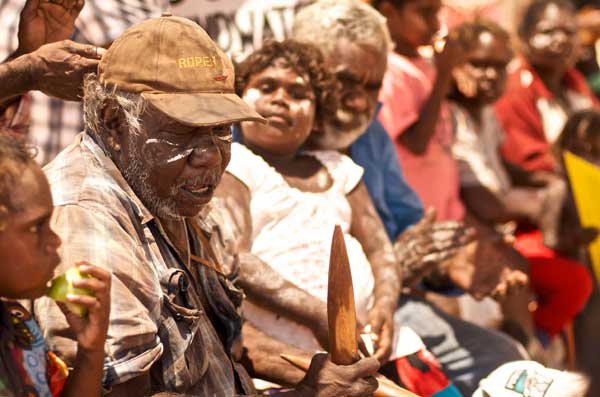Clan groups united in protest yesterday in the remote Aboriginal community of Borroloola, in the Northern Territory Gulf Country. The Mambarliya, Wurdaliya, Rumburriya, Wuryarliya clans blocked the bridge over the McArthur river entering Borroloola, then held a rally in the town.
The protest was part of the “Global Frackdown” – a world-wide day of action against “fracking”, a method used by gas companies to access unconventional reserves such as Coal Seam Gas and Shale Gas that has been blamed for contamination of groundwater supplies across the world.
There has been an explosion of license applications by companies looking to frack Shale Gas right across the NT, and traditional owners in the Borroloola region are deeply concerned about potential environmental impacts.
The NT government has commissioned a feasibility study for the installation of a gas pipeline to run through the region and connect the NT with the national gas grid.
The viability of a serious gas industry expansion in the region depends heavily on the construction of this infrastructure. Aboriginal leaders say the pipeline would cut through song-lines and destroy many sacred sites.
Stewart Hoosan was one of many locals who pledged to take direct action, including blockading trucks, if these plans go ahead.
Across the world, Indigenous people have been on the frontline of resistance to fracking. For example, the Global Frackdown also included actions by Mi’kmaq First Nations in Canada, who made global headlines in December 2013 when paramilitary style raids by the Canadian Mounted Police attempted to break their successful anti-fracking blockade.

The Borroloola community has heartbreaking experiences of the destructive impact of extractive industries. The protest also raised strong demands for the closure of the nearby McArthur River mine, one of the largest zinc mines in the world, which was massively expanded in 2007.
The expansion required a diversion of the river, which only proceeded after the NT government passed legislation to override a Supreme Court ruling against the diversion.
The community believes the river has been polluted with heavy metals. Locals say that many species they used to rely on for food have now disappeared and fear that remaining fish are contaminated.
Shirley Simon recounted how she has harvested Oysters from the river her whole life and now can’t find any. Families have to travel 30kms to a different river system to go fishing and won’t drink or swim in the water.
Lauren Mellor from the Environment Centre of the NT, who helped organise the rally said that a growing body of evidence supports the local concerns:
“An independent monitors report has previously identified seepage from the tailings facility into tributaries of the McArthur River,” Mellor said.
“At the request of the community, we assisted with water samples earlier this year which were found to contain high levels of lead and zinc.
“The mining company refuses to test edible fish species, despite the risk of bioaccumulation in the species people rely on for food. But these community protests are pushing government led investigations and we are currently preparing for a visit on Monday from government officials including the Federal Environment Ministry and NT Health and regulatory bodies”.
In the last six months, spot fires caused by reactive chemistry in the mine’s waste rock dump site, have covered the mine site in noxious sulphur fumes. Workers and nearby outstation residents have complained about adverse health impacts from these fumes.
The fires are still not under control. The biggest risk however, will come with the approaching wet season, as acidic run off from the waste rock dump enters the river system.
Mellor says there is potential for contamination all the way out to the Pellew Islands, a National Heritage site.
Further community protests are planned for October 22, when independent monitors are set to release a report detailing the extent of contamination. There has been a strong demand from Elders for the training and employment of young people to independently monitor the mine.
Ultimately, they say the mine must be closed and local community members employed in urgent remediation work.

Many people at the Borroloola rally expressed deep anguish at the loss of the river, in speeches which highlight the profound inter-connection between Aboriginal spirituality, Aboriginal livelihood and the health of the lands.
The community painted their bodies with a ceremonial white-clay, markirra. Children led the march dancing the Ngarbarya, a spirit-being summoned to frighten away tribal enemies.
The memory of the struggles of tribal ancestors was also consistently evoked on the march. Resistance to colonisation has always been fierce in Borroloola, with armed conflict extending well into the first half of the 20th Century.
Advertising for the rally featured a painting by Stuart Hoosan of Garrawa warrior in 1916, painted up with spears preparing for an attack on miners who established the nearby Redback copper mine.
Nancy McDinny said, “those ancestors were with us today. We will never give up. We don’t want to move to a big city. We need to step up the fight against the mining company so we can survive on our lands”.
Asman Rory said, “Our old people fought mining in this region from day one. They knew about the destruction that would follow. We have a message for the government and mining companies – get used to seeing our faces because we are not going anywhere. They say the NT is open for business – but our business is defending the land and that’s exactly what we’re going to do”.
Donate To New Matilda
New Matilda is a small, independent media outlet. We survive through reader contributions, and never losing a lawsuit. If you got something from this article, giving something back helps us to continue speaking truth to power. Every little bit counts.



